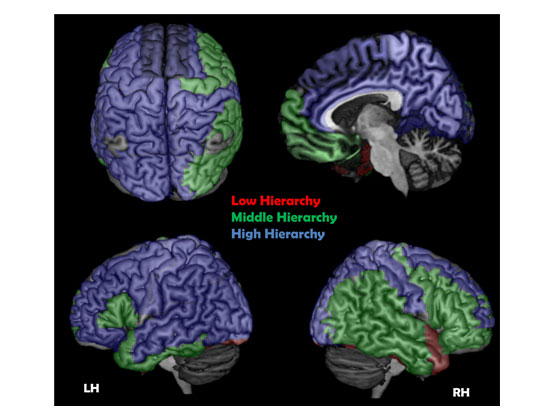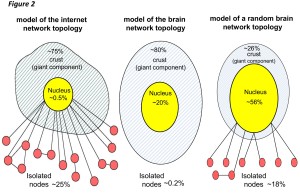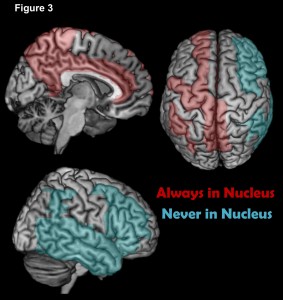Where is my mind? A new study looks for the cortical conscious network
02 Aug 2016 by alisonhadley Image: the hierarchy of the human cortex, Figure 4, New J. Phys.
18 (2016) 083013.
Image: the hierarchy of the human cortex, Figure 4, New J. Phys.
18 (2016) 083013.
Published on behalf of Bar Ilan University.
New research published in the New Journal of Physics tries to decompose the structural layers of the cortical network to different hierarchies enabling to identify the network’s nucleus, from which our consciousness could emerge.
Our brain is a very complex network, with approximately 100 billion neurons and 100 trillion synapses between the neurons. In order to cope with its enormous complexity and to understand how the brain works and eventually makes our conscious mind, science uses advanced mathematical tools. Ultimately, scientists want to understand how a global phenomenon such as consciousness can emerge from our neuronal network.
A team of physicists from Bar Ilan University in Israel led by Professor Shlomo Havlin and Professor Reuven Cohen, used network theory in order to cope with this complexity and to determine how the structure of the human cortical network can support complex data integration and conscious activity. The gray area of the human cortex, the neuron cell bodies, were scanned with MRI imaging and used to form 1000 nodes in the cortical network. The white matter of the human cortex, the neuron bundles, were scanned with DTI imaging, forming 15,000 links or edges which connected the network’s nodes. In the end of this process their network was an approximation of the structure of the human cortex.
Previous studies have shown that the human cortex is a network with small world properties, which means that it has many local structures and some shortcuts from global structures which connect faraway areas (similar to the difference between local buses and cross-country trains). The cortex also has many hubs, which are nodes that have a high number of links (like central stations), that are also strongly interconnected between themselves, making it easy to travel between the brain’s information highways.
According to Nir Lahav, the lead author of the study, “in order to exam how the structure of the network can support global emerging phenomena, like consciousness, we applied a network analysis called k-shell decomposition. This analysis takes into account the connectivity profile of each node making it easy to uncover different neighborhoods of connections in the cortical network, we called shells”. The most connected neighborhood in the network is termed the network’s nucleus. Nir explains, “In the process we peel off different shells of the network to get the most connected area of the network, the nucleus. Until today, scientists were only interested in the network’s nucleus, but we found that these different shells can hold important information about how the brain integrates information from the local levels of each node to the entire global network. For the first time we could build a comprehensive topological model of our cortex”.
 This topological model reveals that the network’s nucleus includes 20% of all nodes and that the remaining 80% are strongly connected across all of the different shells. Interestingly, when we compare this topology to that of other networks, such as the internet, we can see some noticeable differences. For instance, in internet network topology almost 25% of the nodes are isolated, meaning they don’t connect to any other shells but the nucleus (see the ‘legs’ of the medusa shape topology in Figure 2, topology of human cortex, New J. Phys. 18 (2016) 083013). In the cortical network, however, there are hardly any isolated nodes. It seems that the cortex is much more connected and efficient than the internet.
This topological model reveals that the network’s nucleus includes 20% of all nodes and that the remaining 80% are strongly connected across all of the different shells. Interestingly, when we compare this topology to that of other networks, such as the internet, we can see some noticeable differences. For instance, in internet network topology almost 25% of the nodes are isolated, meaning they don’t connect to any other shells but the nucleus (see the ‘legs’ of the medusa shape topology in Figure 2, topology of human cortex, New J. Phys. 18 (2016) 083013). In the cortical network, however, there are hardly any isolated nodes. It seems that the cortex is much more connected and efficient than the internet.
Looking at all the different shells of the cortical network the authors were able to define the network’s hierarchical structure and essentially model how information flows within the network. The structure revealed how shells of low connectivity are nodes that typically perform specific functions like face recognition. From there the data is transferred to higher, more connected, shells that enable additional data integration. Over there we can see regions of the executive network and working memory. With these areas we can focus on task performance for example. (See the above image, the hierarchy of the human cortex, Figure 4, New J. Phys. 18 (2016) 083013.)
 The integrated information then ‘travels’ to the most connected neighborhood of nodes, the nucleus, which spans across several regions of the cortex. According to Nir, “it’s an interconnected collective which is densely linked with itself and can perform global functions due to its great amount of global structures that are widespread across the brain”. (Image: Nucleus of the human cortex, Figure 3, New J. Phys. 18 (2016) 083013.)
The integrated information then ‘travels’ to the most connected neighborhood of nodes, the nucleus, which spans across several regions of the cortex. According to Nir, “it’s an interconnected collective which is densely linked with itself and can perform global functions due to its great amount of global structures that are widespread across the brain”. (Image: Nucleus of the human cortex, Figure 3, New J. Phys. 18 (2016) 083013.)
Which global function might the nucleus serve? The authors suggest the answer is no less than consciousness itself.
“The connection between brain activity and consciousness is still a great mystery” says Nir. The main hypothesis today is that in order to create conscious activity the brain must integrate relevant information from different areas of the network. According to this theory, led by Professor Giulio Tononi from the University of Wisconsin, if the level of integrated information crosses a certain limit, a new and emergent state is entered, ‘consciousness’. This model suggests that consciousness depends on both information integration and information segregation. Loosely speaking, consciousness is generated by a “central” network structure with a high capacity for information integration, with the contribution of sub-networks that contain specific and segregated information, without being part of the central structure. In other words, certain parts of the brain are more involved than others in what we can call the conscious complex of the brain, yet other connected parts still contribute, working quietly outside the conscious complex.
The authors demonstrate how the nucleus and the different shells satisfy all of the requirements of these recent consciousness theories. The different shells calculate and contribute to data integration without actually being part of the conscious complex, while the nucleus receives relevant information from all other hierarchies and integrates it to a unified function using its global interconnected structure. The nucleus could thus be this conscious complex, serving as a platform for consciousness to emerge from the network activity.
When the authors examined the different regions that make up the nucleus they revealed that, indeed, these regions have been previously associated with conscious activities. For example, structures within the brain’s midline which form the majority of the network’s nucleus were found to be associated with the stream of consciousness and some researches like Professor Georg Northoff from the University of Ottawa, have suggested that these regions are involved with creating our sense of self.
“Now, we need to use this analysis on the whole brain and not only on the cortex in order to reveal a more exact model of the brain’s hierarchy, and later on understand what exactly is the neuronal dynamics that lead to such global integration and ultimately consciousness”.
New Journal of Physics publishes across the whole of physics, encompassing pure, applied, theoretical and experimental research, as well as interdisciplinary topics where physics forms the central theme. The journal is published in partnership with the Institute of Physics and the German Physical Society.